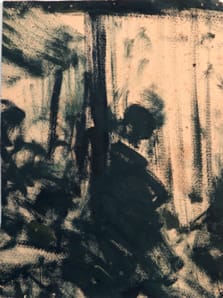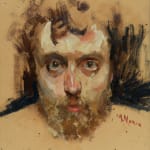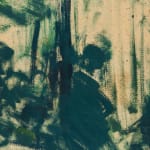-
Artworks


Antonio MANCINI Roma 1852-1930
Self-Portrait (recto) Figure sketches (verso), 1880 c.Oil on cardboard37,8 x 28 cm
SOLDInscribed at the right in red oil paint: A. Mancini (posthumous signature).Provenance
Rossi collection; private Collection, USA.
Literature
A. Schettini, I grandi pittori dell’Ottocento Italiano, la scuola napoletana, Milan, 1961, vol. III, pl. LXVIII; A. Schettini, ibid., 1999, pl. LXXII;C. Virno, Antonio Mancini, catalogo ragionato dei dipinti di Antonio Mancini, Rome, 2019, p. 222, n. 289, illustrated.
Antonio Mancini is regarded as one of the foremost painters of the 19th century, not just in Italy, but throughout Europe. For the American painter John Singer Sargent, his great admirer and supporter, Mancini was ‘The greatest living artist in Italy’. Like his friend Vincenzo Gemito he lived a tormented life, suffering from recurring mental disorders. Mancini’s works are characterised by their absolute mastery of execution and their strong psychological impact, rooted in his study of 17th-century Neapolitan painting and especially his fascination with the work of Caravaggio. Fig. 1
Fig. 1  Fig. 2The present Self-Portrait and the figures on the verso were virtually flung onto the card with rapid and impulsive brushstrokes in oil. This penetrating image staring unflinchingly at the observer belongs to the series of so-called Ritratti della follia (Self-portriats of Madness), dating from 1878 to 1882, and universally regarded by critics as representing the peak of Mancini’s career. Michele Sciuti explained that through these self-portraits Mancini analysed, scrutinised and explored his fluctuating psychological state of mind through what could be described as a kind of pictorial ‘diary’ or ‘autobiography’.[1] All these works were executed within a short space of time, beginning in 1878. Mancini’s symptoms of mental instability first manifested themselves the moment he returned to Naples from Paris, culminating in a year-long hospitalisation in a specialist unit where he underwent occupational therapy.He found peace only in painting compulsively, with a highly charged sense of absorption. This gave rise to highly dramatic works – the present Self-Portrait of Madness being one of them – in which Mancini, full-face, stares intensely and unflinchingly at the spectator.The stark compositional format of the present oil on paper suggests it was executed – though with far greater freedom – shortly before three specific self-portraits: the first of 1880 in which he laughs somewhat manically at the spectator (fig. 1);[2] the second in which he chews on a wheat stalk;[3] and the third showing Mancini brushes in hand, with his dedicatory inscription dated 1882 (fig. 2).[4]Together, these four self-portraits are undoubtedly the finest of the Autoritratto della Follia series.The monochrome figures on the verso (fig. 3), also freely and rapidly executed, immediately bring to mind Mancini’s extraordinary monotypes, best represented in a highly interesting group preserved in the Gabinetto Disegni e Stampe degli Uffizi, Florence.
Fig. 2The present Self-Portrait and the figures on the verso were virtually flung onto the card with rapid and impulsive brushstrokes in oil. This penetrating image staring unflinchingly at the observer belongs to the series of so-called Ritratti della follia (Self-portriats of Madness), dating from 1878 to 1882, and universally regarded by critics as representing the peak of Mancini’s career. Michele Sciuti explained that through these self-portraits Mancini analysed, scrutinised and explored his fluctuating psychological state of mind through what could be described as a kind of pictorial ‘diary’ or ‘autobiography’.[1] All these works were executed within a short space of time, beginning in 1878. Mancini’s symptoms of mental instability first manifested themselves the moment he returned to Naples from Paris, culminating in a year-long hospitalisation in a specialist unit where he underwent occupational therapy.He found peace only in painting compulsively, with a highly charged sense of absorption. This gave rise to highly dramatic works – the present Self-Portrait of Madness being one of them – in which Mancini, full-face, stares intensely and unflinchingly at the spectator.The stark compositional format of the present oil on paper suggests it was executed – though with far greater freedom – shortly before three specific self-portraits: the first of 1880 in which he laughs somewhat manically at the spectator (fig. 1);[2] the second in which he chews on a wheat stalk;[3] and the third showing Mancini brushes in hand, with his dedicatory inscription dated 1882 (fig. 2).[4]Together, these four self-portraits are undoubtedly the finest of the Autoritratto della Follia series.The monochrome figures on the verso (fig. 3), also freely and rapidly executed, immediately bring to mind Mancini’s extraordinary monotypes, best represented in a highly interesting group preserved in the Gabinetto Disegni e Stampe degli Uffizi, Florence.
Fig. 3 - Study for Two Figures verso
[1] M. Sciuti, ‘La malattia mentale di Antonio Mancini’, fascicule III of the journal L’Ospedale Psichiatrico founded by Michele Sciuti, Naples, 1947.
[2] U. W. Hiesinger, Antonio Mancini, Nineteenth-Century Italian Master, exhibition catalogue, New Haven & London, p. 41, fig. 22.
[3] Ibid., p. 41, fig. 20.
[4] Ibid., p. 45, fig. 23.
1of 125
Join the mailing list
Subscribe to our newsletter to receive all the news about exhibitions, fairs and new acquisitions!



